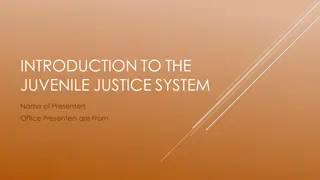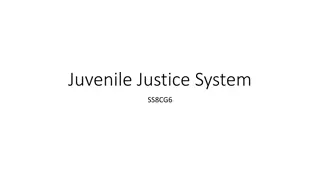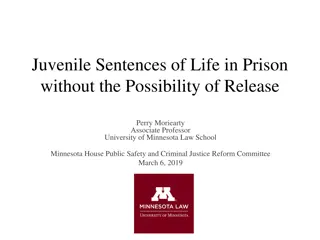Juvenile Firesetters and Bomb Makers: Public Safety Concern
Regarding Juvenile Firesetters and Bomb Makers as a growing public safety issue: statistics on fires, deaths, and property damages caused by JFSBs, along with common characteristics like aggression and social skills deficits. Explore the potential motives behind their actions and the need for intervention strategies to address this concerning behavior.
Download Presentation

Please find below an Image/Link to download the presentation.
The content on the website is provided AS IS for your information and personal use only. It may not be sold, licensed, or shared on other websites without obtaining consent from the author. Download presentation by click this link. If you encounter any issues during the download, it is possible that the publisher has removed the file from their server.
E N D
Presentation Transcript
About OMICS Group OMICS Group International is an amalgamation of Open Access publications and worldwide international science conferences and events. Established in the year 2007 with the sole aim of making the information on Sciences and technology Open Access , OMICS Group publishes 400 online open access scholarly journals in all aspects of Science, Engineering, Management and Technology journals. OMICS Group has been instrumental in taking the knowledge on Science & technology to the doorsteps of ordinary men and women. Research Scholars, Students, Libraries, Educational Institutions, Research centers and the industry are main stakeholders that benefitted greatly from this knowledge dissemination. OMICS Group also organizes 300 International conferences annually across the globe, where knowledge transfer takes place through debates, round table discussions, poster presentations, workshops, symposia and exhibitions.
About OMICS Group Conferences OMICS Group International is a pioneer and leading science event organizer, which publishes around 400 open access journals and conducts over 300 Medical, Clinical, Engineering, Life Sciences, Phrama scientific conferences all over the globe annually with the support of more than 1000 scientific associations and 30,000 editorial board members and 3.5 million followers to its credit. OMICS Group has organized 500 conferences, workshops and national symposiums across the major cities including San Francisco, Las Vegas, San Antonio, Omaha, Orlando, Raleigh, Santa Clara, Chicago, Philadelphia, Baltimore, United Kingdom, Valencia, Dubai, Beijing, Hyderabad, Bengaluru and Mumbai.
Can Pre-treatment Motivational Groups in FATJAM Promote Therapeutically-Relevant Changes for Juvenile Fire Setters and Bomb Makers in a Forensic Psychological Setting? Ronn Johnson, PhD, ABPP, Michelle Jimenez, M.A.*, Derrick Young, M.A.* University of San Diego
Juvenile Firesetters and Bomb Makers Juvenile Fire Setters and Bomb Makers have increasingly become a public safety concern. Annually JFSBs account for: o 80,000 structure fires o 300 deaths o $1.2 Billion in property damages JFSBs account for 50% of arson arrests in the U.S. and 60% of annual residential fires. (FBI, 2011) Average age ranges from 9-12 years old, with males making up 80-90% of JFSBs. (Gilman and Haden, 2006)
Individual Characteristics Common characteristics displayed by JFSBs include: o Aggression o Social Skills Deficits o Deviance and Vandalism o Covert antisocial behavior o Difficulty expressing emotions Fires may be venues for relieved boredom, pure impulsivity, or covert means of retaliation. (Gilman and Haden, 2006)
FATJAM and Previously Used Treatment Options Forensic Assessment and Therapeutic Jurisprudence Assessment Model is an evidence based treatment approach o Cognitive behavioral framework o Risk oriented skills-based mental health intervention program (Johnson, 2010) Community based treatment options o working in conjunction with police and firefighters o in-depth interview style assessment recommended. (Slavkin, 2002)
Motivational Interviewing in Group Therapy Motivational Interventions allow for several avenues of approach o Different theoretical orientations o Immerse several SES backgrounds with one common purpose MI is used with the consideration of three main purposes: o enhance retention and engagement in treatment o improve motivation for change o change behavior (McMurran, 2009)
Purpose of Treatment Serves a purpose not just for the juvenile offender Allows family as well as therapists to help break the cycle of different social behaviors Shows a peaceful way to utilize the decision making process Gives insight on how juveniles are not perpetrators, but victims of repeated events of crime (Center for Early Adolescence, 2011) Cognitive skills are tested in several ways Demonstrates anger Express daily thought processes with family, friends, and other populations
MI Interventions For JFSBs In A Group Context (MI) is an evidence-based approach that is an effective means of engaging juvenile offenders in needed services (Stein et al. 2006) Methods of conducting interventions group discussions amongst all participants eliciting and evoking change talk (what would they want, need, or desire to happen) (Doran et al. 2011)
Continued Different Therapies music- best relates to and puts them in a calm state expressive- what can be written, or oratorical presentations play therapy- physical activity as well as mentally challenging strategies Exploring Confidence develops ways to build self- esteem become more sociable with peers expressive in nature as opposed to limited with communication (Doran et al. 2011)
Prior Steps to Group Therapy Interview Process Ask questions and assess chronic issues Develop a group with common interests Questionnaires, assessments (Yalom, 2007) Orientation Explanation of goals and terms Establish limitations and expectations Build relationship with trust
Treatment Process Duration o Gender mix, separate meetings o Develop mentorship program o Counsel through sub groups Challenges o Shift through different therapies o Ethnic, gender inequalities o Modifying existing groups (Rose, S. 1998)
MI as Pre-treatment for JFSBs MI as a pre-treatment option to CBT has been found to: o increase positive outcomes and compliance with homework o higher expectancy in one s ability to change o may be considered a catalyst to initiating change prior to beginning treatment session. (Westra & Dozois, 2006) Therapist pre-group preparation considerations for group therapy: o screening interview o psychiatric history o mental status examination o Inclusion criteria o Exclusion criteria (Gupta, 2005)
Biopsychosocialcultural Factors Related to Pre-Treatment in JFSBs MI Groups Socioeconomic Status wealthy as opposed to lower class citizens different privileges available to several backgrounds abundance of resources available compared to limited communities Emotions/Psychological many may not have received love from family and loved ones difficulties expressing their anger and frustration in a more positive way may promote a more resilient mindset to change behavior (Singh, A.N. 2007)
Continued Ethnic/Cultural can determine what population they communicate with different mentalities on how they may interact with the general population can be a positive way to see the other side of other ethnicities
Therapeutically Relevant Changes Associated with MI Group Therapy for JFSBs Major Changes more positive outlook on how to communicate examines the social impact that is seen toward a certain culture allows for better ways of being expressive with emotions Roles juveniles have become more vocal with peers and have a more positive regard to emotions Parents may find avenues to become more relevant in the lives of an adolescent(no control issues) (Singh, A.N. 2007)
Future Implications Research focus on: o Individual responses to MI intervention retention, motivation to change, and recidivism o Group reactions to MI interventions within a forensic clinical setting o Interferences with FATJAM model o Clinician training of MI in implementing pretreatment strategy. (McMurran, 2009)
References Almont, T. (2003). Creative interventions for juveniles incarcerated for violent crime: A workbook for violent youth. Dissertation Abstracts International, 64, 2377. Doran, N., Hohman, M., & Koutsenok, I. (2011). Linking basic and advanced motivational interviewing training outcomes for juvenile correctional staff in California. Journal Of Psychoactive Drugs, Sarc Suppl 719-26. Galejs, I., & Stockdale, D. F. (1982). Social competence, school behaviors, and cooperative-competitive preferences: Assessments by parents, teachers, and school-age children. The Journal Of Genetic Psychology: Research And Theory On Human Development, 141(2), 243-252. Gilman and Haden. (2006). Understanding and Treating the Juvenile FireSetter A Review. The Forensic Examiner, 11-18. Gupta, A. (2005). Group therapy for psychiatric disorders: an introduction. Mental Health Reviews. Accessed from: <http://www.psyplexus.com/mhr/group_therapy.html> Jensen, D. R., Abbott, M. K., Beecher, M. E., Griner, D., Golightly, T. R., Cannon, J. A. N. (2012). Taking the pulse of the group: The utilization of practice-based evidence in group psychotherapy. Professional Psychology: Research and Practice. Advance online publication. Johnson, R. (2010). Forensic assessment and Clinical Intervention for Juvenile Firesetters: The San Diego Model. Matchbook Journal on Prevention & Treatment of Youth Firesetting. Juvenile Arson and Explosives Research and Intervention. http://www.burninstitute.org/fire-andburn-prevention/juvenile-firesetter-program
References Letourneau, E. J., & Borduin, C. M. (2008). The effective treatment of juveniles who sexually offend: An ethical imperative. Ethics & Behavior, 18(2-3), 286-306. McMurran, M. (2009). Motivational Interviewing with Offenders: A Systematic Review. Legal and Criminological Psychology, (14) 83-100. Farkas, M.A. (1999). Correctional officer attitudes toward inmates and working with inmates in a get tough era. Journal of Criminal Justice, 27: 495 506. Slavet, J.D.; Stein, L.A.R.; Klein, J.L.; Colby, S.M.; Barnett, N.P. & Monti, P.M. (2005). Piloting the family check up with incarcerated adolescents and their parents. Psychological Services 2: 123 32 Slavkin, M. L. (2002). Child and Adolescent Psychiatry: What Every Clinician Needs to know about Juvenile Firesetters. Psychiatric Services. 53 (10). Tripodi, S.J.; Springer, D.W. & Corcoran, K. (2007). Determinants of substance abuse among incarcerated adolescents: Implications for brief treatment and crisis intervention. Brief Treatment and Crisis Intervention 7: 34 39. Singh, A. N. (2007). Review of Assessing and managing violence risk in juveniles. Journal Of Child And Family Studies, 16(3), 461-463. Doran, N., Hohman, M., & Koutsenok, I. (2011). Linking basic and advanced motivational interviewing training outcomes for juvenile correctional staff in California. Journal Of Psychoactive Drugs, Sarc Suppl 719-26. Westar and Dozis. (2006). Preparing clients for cognitive behavior therapy: A randomized pilot study of motivational interviewing for anxiety. Cognitive Therapy Research, 30(4); 481-498. Shaughnessy, M. F., Main, D., & Madewell, J. (2007). An interview with Irvin Yalom. North American Journal Of Psychology, 9(3), 511-518.
Let Us Meet Again We welcome you all to our future conferences of OMICS Group International Please Visit: www.omicsgroup.com www.conferenceseries.com























